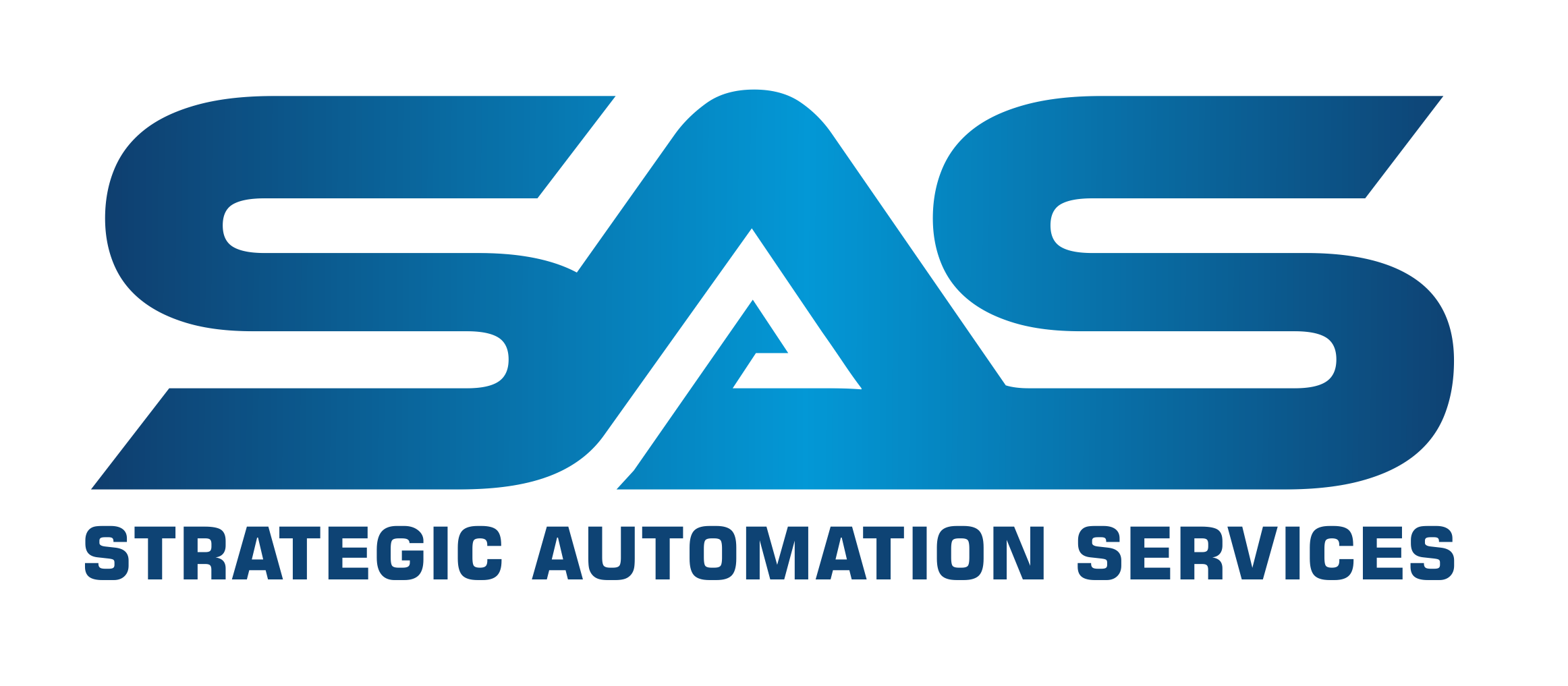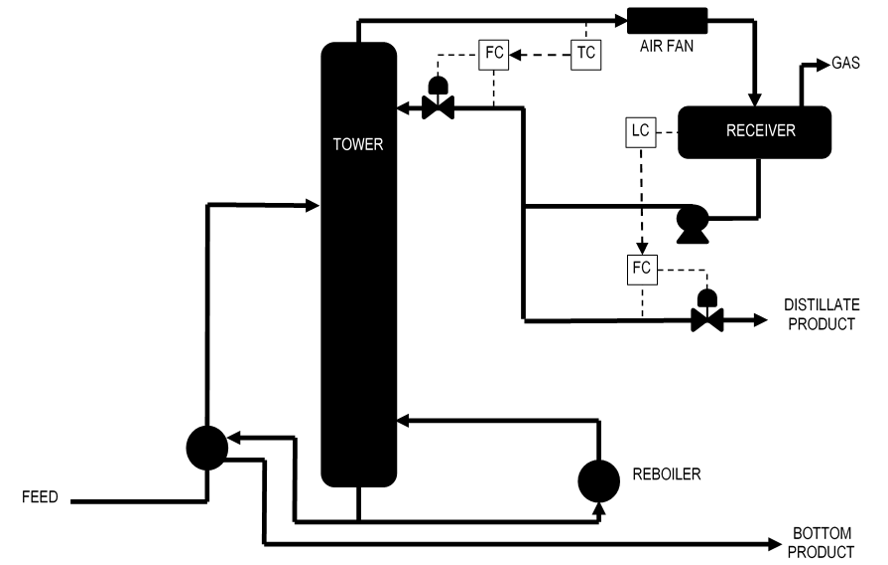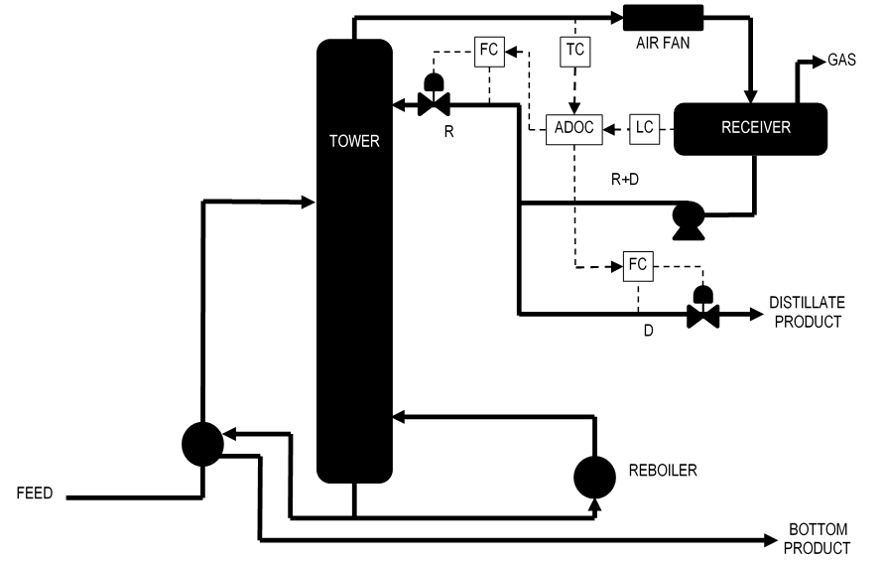Introduction
Refineries employ distillation columns to remove light components from various hydrocarbon streams. Examples are:
- Crude Tower in which naphtha and lighter hydrocarbons are separated from kerosene in the overhead.
- Naphtha Stabilizer in which LPG is separated from naphtha.
- DHT Stripper in which naphtha and lighter are separated from diesel product.
Figure 1 shows the controls that are typically implemented for the overhead section of a distillation tower. The overhead temperature (TC) is controlled by manipulating the reflux (FC), and the overhead accumulator level (LC) is controlled by manipulating the distillate product (FC). Pressure control is not shown because of the many different ways pressure can be controlled.
These typical controls are sometimes victimized by air fan exchangers that are used as overhead condensers. Rainstorms can wreak havoc on the tower by sub-cooling the reflux. This event causes additional vapor to be condensed in the column, thus forcing light components into the bottom product.
The Advanced Distillation Overhead Controls (ADOC) application has been developed to minimize the effect of subcooled reflux. This application is described further below.
Figure 1: Typical Distillation Overhead Controls
ADOC Concept
Figure 2 shows the ADOC scheme. The overhead temperature controller and the receiver level controller both send their outputs to the ADOC logic. The level controller output has been redefined to be the total overhead rate instead of the distillate. The total overhead rate is the reflux rate (R) plus distillate rate (D). The temperature controller output has also been redefined to be the ratio of distillate (D) to total overhead rate (R+D).
The ADOC logic converts the redefined controller outputs into remote setpoints for the reflux flow controller and the distillate flow controller, as follows:
FCliq = TCout * LCout (1)
FCreflux = LCout – FCliq (2)
where:
FCliq = Distillate flow controller setpoint;
FCreflux = Reflux flow controller setpoint;
TCout = Overhead temperature controller output [D/(R+D];
LCout = Receiver level controller output [R+D].
Figure 2: Advanced Distillation Overhead Controls
ADOC Benefits
The main benefit of the ADOC approach is that the receiver level controller now adjusts the reflux as well as the distillate. Therefore, when the level drops due to the colder reflux condensing vapor in the tower, the level controller automatically brings the tower back into balance by reducing the external reflux rate.
Another benefit is the decoupling of overhead temperature and receiver level control. The overhead temperature is an indicator of composition (at constant pressure), which is determined by the ratio of distillate to total overhead rate. The receiver level is determined by the imbalance in the total overhead rate both entering and leaving the vessel.
The typical controllers shown in Figure 1 interact with each other. Overhead temperature control adjusts the reflux which also affects the receiver level. Receiver level control adjusts the distillate rate which affects the composition in the overhead thus affecting the overhead temperature.
In the ADOC approach, the temperature controller adjusts the distillate ratio without changing the total overhead rate, thus not disturbing the receiver level. Likewise, the level controller adjusts the total overhead rate without changing the distillate ratio, thus not disturbing the composition and the overhead temperature.
Another benefit is protecting the average composition of the distillate. When the composition becomes heavier than desired, the overhead temperature rises above setpoint and the control action reduces the distillate flow, thus minimizing the quantity of off-spec product. When the composition becomes lighter, the temperature controller increases the distillate flow, thus maximizing the quantity of on-spec product.
ADOC Features
The ADOC logic includes a maximum rate of change for the reflux setpoint, a maximum reflux setpoint limit, a minimum reflux setpoint limit, and a minimum distillate setpoint limit. The reflux setpoint limits are set to prevent flooding in the column (maximum) and insufficient liquid flow in the column (minimum). If either limit is reached, then the level controller adjusts only the distillate to maintain the level.
The logic also monitors the reflux valve. If it is wide open, the logic assumes that the reflux cannot be increased, so all increases in total overhead flow are taken on the distillate. Functionally, this constraint is the same as hitting the maximum reflux setpoint limit.
When the reflux flow controller is in manual or local, the level controller again adjusts only the distillate, and the temperature controller goes into track mode. Likewise, if the distillate flow controller is in manual or local, the level controller adjusts only the reflux, and the temperature controller goes into track mode. The temperature controller is in control only when both the reflux and the distillate flow controllers are in auto/remote.


